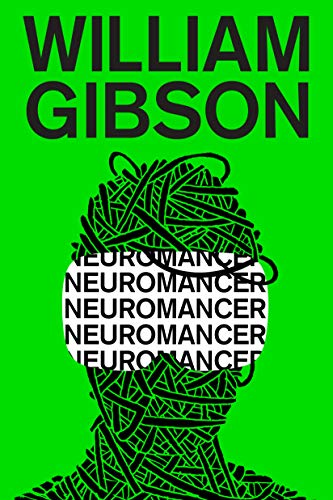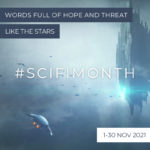
Like any great novel that does something really new, William Gibson’s Neuromancer, can be hard to get into. And it still feels new, at least to me, almost forty years after its publication, despite the fact that cyberpunk has become so common a sub-genre. Neuromancer is so uniquely itself that it’s hard to make the comparisons that help me place a book in a familiar mental comfort zone. From its great opening focused on the television sky, it explodes with metaphors that demand you think differently about reality. When Gibson wrote the novel, there was no accepted language to describe cyberspace or the future urban spaces that could support its functions.
For us today, the web and its interfaces are more familiar as spaces for commercial transactions, hot news, influencers and crazed rumors. But Gibson was interested in a vast metaphorical space for human searching and desperation. His anti-hero Case is a strung-out addict who comes to life mostly when jacked into a computer deck that takes him into the meta-world of thieves, grand heists, terrorists, hideouts for the wealthy and domains of powerful AIs.
As he described in a 2006 interview, his dense language of pseudo-technical jargon is a literary illusion that he generates by sampling fragments from the great flood of information about technology. At the time he wrote Neuromancer, he had never touched a computer. He thought of cyberspace – his coinage – itself as a kind of metaphor. What intrigued me in this re-reading was Gibson’s layering of many kinds of reality, each of which the central character, Case, has to master. And not master in the sense of a game, though the typical heists that lure Case into cyberspace definitely have a game element. In Neuromancer, this becomes a matter of life and functional death. (Be advised, there are major spoilers below.)
Case was once the consummate navigator and thief of cyberspace, with incredible reflexes and speed, but after he stole from one of his employers, they took their revenge by deadening the nerves that were the foundation of his skill. Unable to do the thing he was best at, he withdrew from the Sprawl, the urban expanse in what was left of the USA, to a life of addiction and petty crime in an expatriate section of Chiba City in Japan. Night City is a place where you either constantly hustle or sink into oblivion. It is also an outlaw zone that seemed to exist, not for its inhabitants, but for the testing of new technologies. It was there that Case fell in love with Linda Lee, only to watch her shrivel into addiction and, early in the story, die a violent death.
A strangely artificial-looking man name Armitage, whose body and mind were rebuilt by his mysterious employer, hires Case for a complex cyberspace hack. To make him functional again, Armitage sends Case to a clinic where his nerves are restored, but he is also fitted with a timed-release toxin that will take away his abilities again if he fails to accomplish the mission on time. Case teams up with the agile assassin, Molly, with built-in shades permanently covering her eyes and razor-sharp knives that can extend from her fingertips. With a couple of other allies, he sets about his assignment of penetrating one of the most elaborate AIs in the world. It protects the domain of the Tessier-Ashpool industrial family who reside in Freeside, an orbital satellite that is part Las Vegas and part Geneva for its financial importance. Their home is called Straylight in the most remote and heavily guarded part of the satellite.
Case and Molly get help from the stored consciousness of another hacker, McCoy Pauley. They also recruit Peter Riviera, a sociopathic thief and performer who can generate holograms of himself. When this strange team gets to Freeside, Molly takes on the task of physically penetrating the Tessier-Ashpool defenses, and Case jacks in to her consciousness as a rider, able to see and feel what she experiences but unable to speak to her. The AI known as Wintermute, originally created by the Tessier-Ashpool family, stays in touch with Case, not to oppose him but to gain his help in uniting with his sibling AI, known as Neuromancer.
Wintermute has been behind the operation and Armitage all along. Case’s journey through Straylight as a rider and through its larger cyberspace becomes a test of his humanity as well as the effort to bring down Tessier-Ashpool. Molly encounters the elder Ashpool, who seems in the midst of committing suicide, and she helps him on his way. She has to get a crucial key to unlock a hidden part of Straylight cyberspace from Lady 3Jane Marie-France Tessier-Ashpool, the CEO of the family’s corporation. Molly is blocked by the crazed Riviera who wounds her terribly, but 3Jane has no use for him and sends her assassin Ninja, Hideo, to track him down. The story is full of diversions, turnabouts and knotty situations that keep complicating Case’s mission, but as he breaks through a crucial barrier in the matrix, he finds himself in a strange place.
Neuromancer appears as a boy on a deserted beach to Case’s jacked-in mind. There he has a confrontation that helps him see a clear picture of his addicted self. The AI tells him that the only way he can successfully complete his mission is to ride in on the most powerful emotion he can feel. That turns out to be hate and loathing for himself, and by letting himself be fueled by that instead of drugs he is able to get through. By helping Wintermute and Neuromancer come together, he is able, in a way, to restore himself. The combined AI is a powerful force, perhaps the whole matrix, that is searching the cosmos for other intelligences.
Of course, that’s a vast oversimplification of Case’s drug-filled and violent journey through multiple levels of reality in multiple physical locations and regions of cyberspace, each with their traps and deadly opponents. But through the novel, I kept going, at times simply for the language Gibson invented to capture the distorted realities of the spaces he imagined.
“His mouth filled with an aching taste of blue. His eyes were eggs of unstable crystal, vibrating with a frequency whose name was rain and the sound of trains, suddenly sprouting a humming forest of hair-fine glass spines. The spines split, bisected, split again, exponential growth under the dome of the Tessier-Ashpool ice.”
Neuromancer, Kindle edition, Location 3949
Neuromancer is not an easy book to read, partly because the cyber-poetry of Gibson’s eclectic imagination throws its dazzling, prickly excesses at you to force the mind to accept a unique vision of a world where boundaries blur between levels of reality. It’s intense reading that I keep coming back to, each time seeing things I had missed before.





Leave a Reply